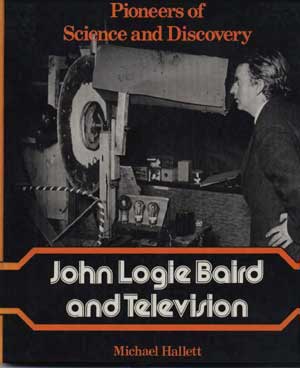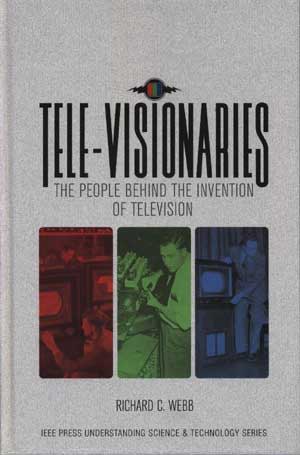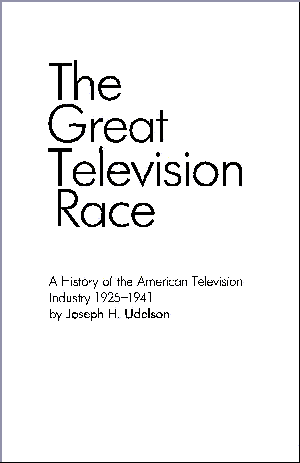Television has many fathers
|
|
|
Baird Tradition of Promotion. You Baird webmasters are following a proud tradition of publicity. You're in great company. Baird himself, ever mindful of the press, started this very tradition. Consider Baird's promotional demonstrations. For example, mechanical color TV, stereoscopic TV and phonovision. None of these so-called "inventions" advanced the art. None of them even went into production. All of them had serious flaws, including a terrible flicker rate. Impractical? Yes! Yet Baird's technical fancies spurred the imagination. As inventions, these demonstrations had little value. But as promotions, the demonstrations were huge.
Baird's publicity stunts attracted press exposure and brought in investment capital. Meanwhile, Baird's successful competitors concentrated on improving the technology. They increased image clarity, resolution and size. They also developed the CRT and television marketing methods. And they stole a march on John Baird. Through these years, Sydney Moseley, a very shrewd PR man, was one of Baird's most loyal supporters. Baird and Moseley could out-promote even many larger rivals. The strategy was bold, clever and often effective. It was one of Baird's greatest, yet least recognized contributions to television. But in the end, the Baird product couldn't outperform or even equal its competition. In 1935, the British postmaster discontinued low-definition television service over Baird's 30-line system. In 1937, the Selsdon Committee decided against Baird's medium-definition service. Instead, Great Britain adopted the 405-line, Marconi-EMI system. The new system was all-electronic television, with its basis in Vladimir Zworkyin's RCA patents.
Writing History. Moseley's renowned Baird biography is only one volume in a stack of pro-Baird books. If you love mechanical television, you must have read a few of these tracts. If you belong to the Baird publicity machine, you might have written a few. Then let's also mention the many museums that promote the blarney about Baird inventing television. It's a compelling yarn, but it isn't true. The theory of Baird apologists, all the way back to the man himself, is this: History is even more powerful if you can write your own. Baird shares this rather Machiavellian theory with another television luminary, David Sarnoff. For both men, publicity was a key to success.
Off the shelf. Baird was a major contributor to television. Yet he used off-the-shelf technology. So did many other "fathers of television" who were Baird's contemporaries. Baird publicist Iain Baird is John Baird's grandson. Iain insists that "television simply did not exist in 1924" and that television didn't evolve. These notions cast scorn on scientists who preceded Baird and supported his success. These notions also assume that television history had a single strand. Untrue. Parallel television technologies existed before, during and after Baird. For example, Baird had little or nothing to do with early developments in picture tubes. Page 1 of this article names many television scientists who came before Baird. That Baird used their work is a recorded fact. What work? For example, such essentials as these: The Nipkow scanner, the Moore lamp, and amplifiers full of de Forest audion tubes.
History vs. dogma. For those who want history and facts instead of dogma, consult our Web site. And read the other pages on this domain. If you doubt any statement, check it in a reputable book on technology history. A true television history has many pages or even entire chapters before Baird shows up. We suggest the books below. One of these books might be in the reference section of your library. Many universities own the books. If your library doesn't, ask your reference librarian to arrange an interlibrary loan.
Resource Links
Books
- Abramson, Albert. The History of Television, 1880 to 1941. Jefferson, North Carolina: 1987. Although this book is mainly textual, the story isn't a narrative. Instead it's more of a database. Use the index to take you to an inventor, television station or company. Then read the references on that topic. Throughout the book are historic photographs, including some pages from patents. One of the patents is Paul Nipkow's. Nipkow's 1884 patent #30105 details a complete mechanical television scanning system. Germany granted the patent four years before Baird's birth. Most mechanical television inventions, including Baird's, are improvements on Nipkow's work. The mechanics come from the nineteenth century. The electronics come from the early twentieth century. Both types of parts predate John Baird's television contributions. Abramson's book includes an ample bibliography and glossary.
- Shiers, George. Early Television: A Bibliographic Guide to 1940. New York: Garland Publishing, Inc.: 1997. This isn't a normal annotated bibliography. Read the chapter-heading articles. They're completely fascinating. In fact, they're like a book within a book. Actually Shier's bibliography is a team project. George Shiers compiled the bibliography and May Shiers assisted him. Diana Menkes edited and indexed the book. The project manager was Christopher H. Sterling. The editorial Associate was Elliot N. Sivowitch. Historian Albert Abramson (of the above text) is uncredited, but he provided advice. Shiers died before he finished his book. Sterling and the staff completed it. Tony Bridgewater, an eminent engineer who once assisted John Baird, wrote an excellent foreword. One of Shiers' articles (p. 64) notes that Baird re-patented the Nipkow disc. This alleged patent might be an example of plagiarism.
|

|
- Dunlap, Orrin E., Jr. The Outlook for Television. New York: Arno Press and the New York Times, 1971. This is a reprint of a famous 1932 book by the New York Times' then radio editor. Here's a quote from page 5: "Television is not the triumph of any one man, but of many. No one can be called the inventor." On page 75, Baird himself admits that repeating telegraphy solved "the sync problem." Page 84 reveals this about noctovision: German television inventor Ernst Ruhmer owned prior patents on infrared television. When Baird discovered this fact, he ended his noctovision research to concentrate on television.
|

|
|

|
On the Web
- Baird revisionism critique. We suggest this article by British television historian Andrew Emmerson. This source isn't an exhaustive history. Instead, it's a criticism of historical distortions by publicists. Several paragraphs down, you'll find appropriate comments about the current Baird revisionism. Emmerson is the founder and former editor of the journal 405 Alive. Readers of this journal are fans of the obsolete British 405-line televison service. Many of these readers are unusually technically literate. They restore, reproduce, collect and exhibit 405-line television equipment. See 405 Alive.
- The World's Earliest Television Recordings. Don McLean's page on restoring Baird phonovision recordings. A charming site with commentary and squibs of mechanical television recordings. Opening comments contrast the "provincial" view of one television inventor against the broader, worldwide view. In fact, McLean, who like John Baird is Scottish, mentions television inventors from many countries. McLean continues that Baird used "no new major developments."
- Mostly Pro-Baird forum about our quiz page. Baird zealots, we appreciate and share your enthusiasm! Thanks for promoting our quiz page. This forum site includes many other mechanical TV topics. These topics include technical discussions from the beginning to the engineering level. You'll also find other historical conversations here. If you're more interested in early literature or patents, the site has a small library of those sources, too.
|
| Go to Page: 1 2 3 4 5 Next |
|
|
|
|
